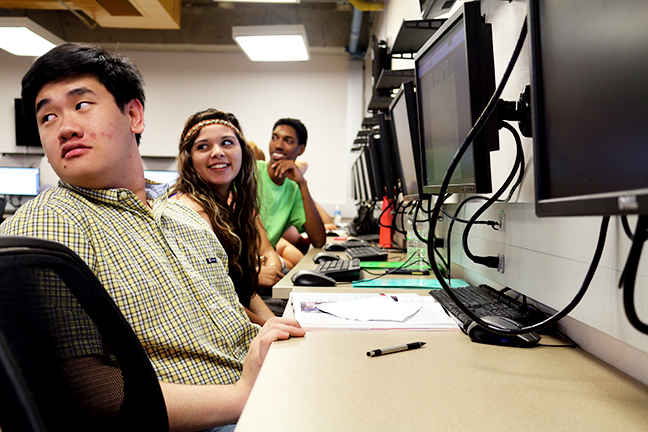Interactive classrooms added on campus

Five televisions adorn the walls. More than 20 computer monitors and keyboards are mounted below the TVs. An interactive 87-inch screen hangs at the front of the room.
Welcome to English Composition at OCCC.
Through an inter-departmental effort, the English and Humanities department now has three newly redesigned classrooms — and this is just the beginning, said Technology Support Services Director Tim Whisenhunt. He said this is the future of many campus classrooms. The plan is to have two interactive classrooms in each division, he said.
Glenné Whisenhunt, Center for Learning and Teaching Director, said the college is using the new technology to benefit students.
“We have a lot of digital interaction with the content in the classroom,” she said.
“We know that many of our students interact with a lot of digital content on a daily basis. It’s to our benefit to allow them to interact with our teaching content in the same way.”
Whisenhunt said she chaired the committee that was formed in spring 2015 to seek out how to redesign classrooms.
She said the committee was comprised of division deans, two faculty members from each division, CLT representation, facilities management employees, IITS employees and student input.
Whisenhunt said the classrooms were redesigned under a Title III grant.
In the classroom, lightweight tables on wheels can be set up in a number of ways to suit the needs of instructors, Tim Whisenhunt said.
He said moveable chairs and desks minimize the distance between students and faculty, making the classrooms more flexible than with the previous classroom setup.
“It can be quite disruptive to change from a lecture-type setting to push all your chairs together to form a group,” he said. “This is real quick — everything’s on wheels, everything’s light. It gives you more space.”
He said the three classrooms in the Arts and Humanities building feature what the committee has dubbed “genius boards” — similar to Smart Boards but with more features.
The televisions can be used to project screen images or professors can project materials on the screens for the entire class to see, he said.
Diversified Studies major Tracy Dilbeck said the older design made it difficult to do group projects.
“It was pretty cramped,” Dilbeck said. “There were four to a table, but we had to have six to a table for groups because it was a big class.”
English and Humanities Dean Kim Jameson said English Composition and Success in College and Life professors are responding positively to the way the classrooms are now designed.
“The teachers love it already,” Jameson said.
“What they like is they can move it all around very easily and do different things within the same class period with their students — so it really helps with what they’re working on.”
Jameson said transformative learning places an emphasis on collaboration, something she said is essential in the workplace.
David Anderson, Information Technology vice president, said it cost $20,000 in technology purchases to complete each classroom. He said the rooms cater to all teaching styles.
“No matter what type of teaching style the instructor has, they can lay the room out however they want to,” Anderson said.
“There’s all kinds of things to do and we’re just now exploring options with faculty and staff as we get them trained on this so it’s going to open up a new avenue of things for them to do.”
The interactive classrooms are located in the Arts and Humanities Center, in classrooms 2E3, 2E5 and 2F2. For more informations, email twhisenhunt@occc.edu, or call 405-682-1611, ext. 7349.